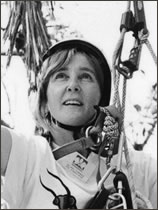 Dr. Pam Matson, drawn by Miles Traer. Dr. Pam Matson, drawn by Miles Traer. Pam Matson discusses her agricultural research in the Yaqui Valley and how it relates to the Green Revolution. She also reflects upon the politics of sustainable agriculture and how we might go about feeding the 9 billion people we expect in the coming decades. As a final thought, she offers some advice to those who are coming of age in the Anthropocene, and why we shouldn’t waste our time trying to assign blame. Pamela Matson is an interdisciplinary Earth scientist who works to reconcile the needs of people and the planet. Her research addresses a range of environment and sustainability issues, including sustainability of agricultural systems; vulnerability of particular people and places to climate change; the consequences of tropical deforestation on atmosphere, climate and water systems; and the environmental consequences of global change in the nitrogen and carbon cycles. With multi-disciplinary teams of researchers, managers, and decision makers, she has worked to develop agricultural approaches that reduce environmental impacts while maintaining livelihoods and human wellbeing. [LISTEN IN] Published in Grist
What ever happened to “Save the whales”? In the 1970s and ’80s, it was the quintessential environmentalist cause, the one that anyone who cared about the earth could unequivocally rally behind. It was the topic of international negotiations and treaties, and endless campaigns from environmental groups. (“Uh-oh, that guy down the street with the long hair has a clipboard, and is that a Greenpeace T-shirt he’s wearing? Quick, act busy!”) These days, we’ve got bigger things to worry about — climate change, mass extinction that could wipe out half of the species on the planet by mid-century, and a human population rocketing toward 9 billion. 'Canopy Meg' wants you to care about the rainforest. Podcast interview with Dr. Meg Lowman7/20/2012
Meg Lowman climbs trees for a living. A botanist by training, she wanted to study the rainforest canopy. The only way to get answers, she says, was to get up there herself. So back in the 1970s, using her own makeshift equipment, she figured out how.
“It’s amazing to me to think that only in the last 40 years have we explored the tops of trees,” says Lowman, the director of North Carolina’s Nature Research Center. Walking down a rainforest trail, it may seem like there’s a lot going on, but that’s really only a small slice of the whole picture, she says. “It’s almost like going to the doctor and if he checked your big toe and said ‘Oh, you’re perfectly healthy.’ It’s just such a small part of the whole body of the forest.” Unfortunately a lot of what she’s found up there isn’t nearly as fun as the process she uses to discover it. “I’m going to level with you that I get pretty depressed about what’s going on with deforestation,” Lowman says — and it’s not just the critters that are suffering. “We’re seeing enormous quality of life disappearing for many cultures because of our greed and our lack of understanding.” I spoke with “Canopy Meg” about her tree-climbing exploits, the power of Google Earth, and the importance of spirituality in rainforest conservation. [LISTEN IN] Published on Grist A lone rider spurs his horse as he gallops across the desolate plains. An explorer heads into the Sierras, the cathedrals of the wild. These are the classic images of the frontier and the romantic heroes who pushed into the wilderness to build the American West. They are also relics of a time when we could imagine that the human and natural worlds were separate. “It’s as if the idea of the frontier kept open the illusion that there was more nature out there that was as yet unaffected by human beings,” says environmental historian Jon Christensen, executive director of the Bill Lane Center for the American West at Stanford University. “That really never did exist.” “We now see, in the Anthropocene, that even the wilderness is a product of human forces and is very much shaped by human ideas,” Christensen says. “The city is also full of nature.” These insights will be crucial as Earth’s population continues to grow to the 9 billion people we expect in 40 to 50 years, and as we continue to cluster in urban areas. In this brave new world, the frontiers will be urban ones, where humanity and nature mix and interact. The ways in which we allow these cities to grow and absorb the population, thus affecting the natural environment within and around them, is “going to determine so much about the future of life on Earth for people and the way we live,” Christensen says. Can we design cities in a way that fosters both human and ecological health? “That,” Christensen says, “is the 9 billion-person question.” I sat down with Christensen recently to talk about the mythos of the frontier, “ecological urbanism,” and the questions that remain for Generation Anthropocene. [LISTEN IN] Originally published on Grist. |
Samantha's
Archives
July 2016
Categories
All
|

 RSS Feed
RSS Feed